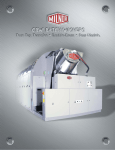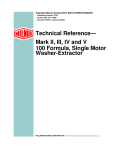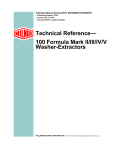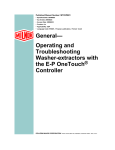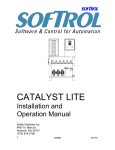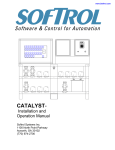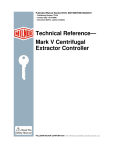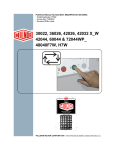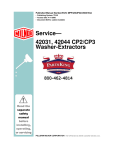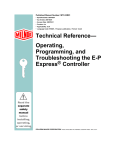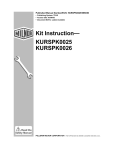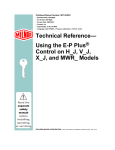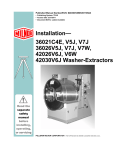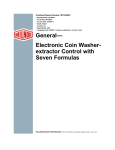Download General Manual - Whaley Food Service
Transcript
A variety of arrangements. Each Milnor CBW washer is custom-made for the customer’s specific needs. More modules give greater production. Water inlets and drain valves give greater flexibility. Mentor control allows predetermined temperature and chemical levels for each individual bath. Mentor® Control. The operator puts a batch in line for loading, then enters the goods classification number into the Mentor control. This automatically selects the processing formula which follows the batch until it’s automatically unloaded from the dryer and delivered to its finishing destination. Loading. A conveyor or overhead bag system may feed the load chute. Washing. Each module has a stationary shell – to hold the wash bath – and a rotating, perforated inner cylinder. Each module can be used for different baths. Goods proceed through the formula by traveling from module to module, via a perforated top transfer scoop. There are no stops and starts for draining and filling after each bath. This saves time, compared to conventional washing machinery. Temperature controls. Any module can be equipped with a steam inlet and temperature probe. Supplies. Supply inlets can be placed in each module. The Mentor control dictates the amount of supplies and when – or if – they are added to the specific goods in each module during the wash cycle. Post-wash. The MultiTrac system relays each batch’s post-wash requirements to other parts of the system – extractor, shuttle, dryers, and conveyors. A CRT display identifies batch location and status. Where multiple-batch dryers are used, the control system prevents mixing of incompatible batches in the same dryer. 1 Tunnel washers were developed to save water, energy and labor, and to expedite the flow of goods through the laundry. Since they entered the market in the 1960s, they’ve all done this to some degree. Early tunnel washers were bottom transfer machines. To move the goods from one stage of the washing process to the next, they transferred the goods and ALL the water along the bottom. Even the first successful batch tunnels did this. And today, the same is still true of some tunnel washers made by others. linen to heavy-soil industrial goods can be laundered in a Milnor CBW washer. But the Milnor CBW washer has taken tunnel washing another step forward. This is a top transfer machine. It lifts and drains the goods before transferring them into the next processing stage. There are other features that set a Milnor CBW washer apart from other tunnels – such as modular construction and double drum characteristics throughout. What distinguishes a Milnor tunnel washer from the competition are better dilution, higher wash quality and more rugged construction. This results in a high level of wash quality for a range of goods – everything from light hospitality 2 Top transfer increases productivity. Milnor top transfer CBW washers have proven higher productivity in more than 1,300 installations worldwide. They wash faster than other tunnel washers due to superior dilution – which means better soil removal. This yields two major advantages: B More production in a given number of compartments, or… C Fewer compartments to achieve the same production. Both of these advantages save wear and tear on the goods. Milnor’s better washing quality – and higher productivity – result from: •Better dilution. •Better wash liquor penetration. •Better mechanical action. •More cylinder space. Better dilution means processing. The proven result of all of this: Dilution is far greater in a Milnor than in other tunnels. That’s the main reason Milnor can wash and rinse more quickly, and why Milnor can also wash heavily soiled goods so well. Why Goods Get Cleaner Faster With Total Top Transfer. Milnor’s perforated top transfer scoop leaves dirty water behind. Linen see cleaner water in the next bath - for better dilution. Note bath separation. How transfer affects dilution. A tunnel washer’s transfer method is critical, because it’s the way the machine introduces each batch of goods to its next bath. And, of course, dilution will be best served if the next bath has cleaner water. Milnor transfers each batch by lifting the goods out of the water, draining the free water, then sliding the goods into the next compartment. Goods are immediately exposed to cleaner water. Only the water trapped in the goods moves forward – most dirty water is left behind. Milnor leaves back approximately half of the total water in each compartment. You can see the effect of total top transfer vs. other methods by using buckets of water to simulate different compartments. A Milnor loading scoop lifts the goods, drains them, and deposits them into cleaner water. Other tunnels transfer by forcing the goods and the dirty water forward, generally along the bottom of the tunnel. Instead of a cleaner bath upon transfer, goods are exposed to the same dirty water that was in the previous bath! That’s why, at the unload end of a Milnor CBW washer, there’s hardly any free water when the goods transfer into the press. Other tunnels have a wave of water splashing into the press, along with the goods. And what happens at the end happens in every other compartment of the machine, as well. 3 Other tunnels send dirty water into the next compartment, along with the goods.There’s no dilution as the whole compartment moves forward. MILNOR’S DILUTION ADVANTAGE Top transfer gives better control of chemicals. Milnor’s top transfer feature assures bath integrity. Baths are truly independent, so the washing formula can work as planned. Because water is not pumped forward with each transfer, chemicals are better targeted to the proper baths. They don’t migrate uncontrollably to subsequent baths. Titrations show that with a Milnor, it is far easier to control pH. What is “True Top Transfer”? To acheive all of the benefits of True Top Transfer, a tunnel washer must include: 1. A scoop that lifts each batch out of the water and transfers it to the next chamber. The results are clear. Dilution is the way goods are washed. It’s always been true of conventional washers and washer-extractors. It’s also true of tunnel washers. Time, temperature, chemicals and mechanical action are essential elements of the washing process. These four things loosen soil from the goods and dissolve/suspend What about counterflow? Counterflow – water moving against the direction of the goods – also achieves dilution. With counterflow, a tunnel washer would get almost the same dilution as a washer-extractor gets with one dump and fill, using reuse water. This is true of both the Milnor top transfer washer and other tunnels. But a Milnor CBW washer, with its perforated top transfer scoop, This video sequence shows how Milnor leaves dirty water behind. Compare Titrations 3. A solid partition between modules to completely separate chemical baths. 6. All flow between modules should be external, so flows can be changed on command when necessary and proper water levels can be maintained. Note the similarity between titration curves of a washer-extractor and a Milnor CBW washer. In both, chemical concentrations are high where soil is heaviest. Then, concentrations drop sharply in the next stage of the formula as soil is removed. HIGH Chemical Concentrations 5. The partition should be fixed to the outer drum so that no sliding seals are required to completely separate baths. goes a big step further. The goods change baths upon transferring. So, again except for reusing the water over and over in each module, Milnor achieves approximately the equivalent of a second dump and fill – and about twice the dilution of some other tunnels. TOP TRANSFER AT WORK: 2. Perforations in the lifting scoop that allow almost all of the “free water” (the water not trapped in the goods) to flow back into the original module and not be carried forward with the load. 4. No perforations in the partitions so bath integrity is maintained at all times. the soil in water. But these four catalysts can only remove soil if water washes it away. That’s dilution – successive baths, each with cleaner water, each replacing dirtier water. Without dilution, the dirt cannot be removed from the linen. Compare this to a bottom transfer tunnel’s flatter curve: Lower peak concentration LOW where chemicals are added 1 2 3 4 5 6 7 8 9 10 11 12 13 14 15 (because so much water has 15-Compartment Bottom Transfer Tunnel been transferred from previous compartments), 1 2 3 4 5 6 7 8 9 and spillover of chemicals in subsequent stages 9-Module Milnor CBW Washer (where a washer-extractor and a Milnor CBW Washer-Extractors washer have already removed most chemicals). 4 More Cylinder Space For Better Wash Liquor Penetration Removes soil effectively. Every module – not just the first – is big, so wash liquor can flow freely into and out of the linens. Milnor’s high mechanical action effectively loosens and moves dirt out of the fibers. Tall ribs are strategically spaced for multiple drops. All cylinders are perforated, and perforations are large and plentiful. Forty percent of the cylinder’s perforated area is open, so water and soil flow easily into and out of the cylinder. Bath separation enhances quality. With a solid partition between each and every wash cylinder, Milnor keeps all baths independent. Water travels from one module to the next via exterior piping, so it is controllable. Better bath integrity helps wash formulas work as planned. Chemicals don’t migrate uncontrollably. MILNOR: Every module is large and of identical size. Milnor gives the goods more space to move. In other tunnels, the first compartment must be large enough (because the goods are bulky before they’re thoroughly wet down). But the rest of a bottom transfer tunnel’s compartments – all the rest – are much smaller. Large cylinder volume allows water and chemicals to penetrate goods more quickly for faster washing in fewer modules. MORE SPACE: In a Milnor, goods open up for better penetration of water and chemicals. TIGHTLY PACKED: Chemicals cannot penetrate the entire load as quickly in a competitive tunnel. More space means more speed. The more space there is, the more room there is for movement of the goods. Goods can open up, so wash liquor – water and chemicals – can penetrate the entire load quickly. Chemicals need time to do their job. Obviously they’ll finish the job faster if they get to the entire load faster. Since Milnor’s low loading ratio and high mechanical action drive water and chemicals into the goods more quickly, the Milnor CBW washer needs less time to wash. 5 Why mechanical action is so important. Mechanical action speeds up dilution. Water and chemicals penetrate the load faster, and soil is removed more quickly. How Milnor Produces Superior Mechanical Action Without mechanical action. With no mechanical action at all, some soil gradually exits the goods. That’s because with water present, some dilution occurs. EXCELLENT WASH ACTION with high ribs. Another reason for Milnor’s speed is apparent if you look down the loading chute, into the first compartment of the tunnel. Lift and drop action is obviously great in a Milnor CBW washer. Milnor provides the kind of washing action you’d only expect in an industrial washer-extractor. In fact, the Milnor CBW washer’s mechanical action has been documented by internationally recognized tests to equal – and even exceed – that of many industrial-size washer-extractors! With mechanical action. Add mechanical action, and soil can exit much more quickly. Mechanical action aids dilution. Dropping the goods squeezes out the water and chemicals inside them. When the goods relax – at the bottom of the cylinder – they open up and absorb more wash liquor. The significance is this: Once goods transfer to a new bath, they must be penetrated by that new bath as quickly as possible. High mechanical action simply aids dilution better than low mechanical action. (And because goods spend less time in the washer, there is less wear and tear!) Three factors contribute to greater turbulence inside the washing cylinder: More space, high ribs that are strategically positioned, and a rotational speed that uses these features to best advantage. Up to 44 drops a minute. Milnor CBW Washer is ideal for industrial soil. Properly-designed batch washers can wash better, faster and at lower cost than any washer-extractor – even when doing heavy industrial soil items. Milnor CBW systems are washing heavy soil to excellent quality standards in plants across the world. 6 In addition to higher wash quality, other advantages are savings in utilities and labor, faster processing of small batches. On-screen tech & PM help. Mentor Control for CBW Washers ® The Mentor controller does much more than alert you to any errors that might occur. It also offers instant, on-screen access to guided troubleshooting steps. It even displays pertinent service procedures and – in many cases – service manual pages. This information can be printed for hardcopy reference. A preventive maintenance alert – with verification requirement – is also available. ® The Mentor® Control expands your laundry’s capabilities and tells you what’s going on. A format that’s familiar, easy to use. Programming is easier & faster. The Mentor controller makes it easier for you to capitalize on the Milnor CBW Washer’s vast capabilities. With graphic displays and mouse-click operation, it saves time in programming and maintenance. Different password levels ensure security and familiar Windows® based format makes all operations more intuitive. This saves training time. Another advantage is one-stop data backup and restoration, using standard media. You program the Mentor controller by formula – not by module – on only one screen. Formulas are virtually unlimited. Shortcuts and timesaving features aid programming. You can define several related output signals (e.g., all alkali valves) as a group. · A formula is programmed step-by-step, entirely on this screen. This includes such functions as chemical injection, bath temperature, formula length, permissible load weights, and assigned dry codes. Formulas get more meaningful names because more characters are available. · The controller signals an error and provides a step-by-step troubleshooting guide. Service manual pages, including illustrations and schematics, can also be viewed on-screen. · The Mentor controller makes several operations automatic – such as chemical dosing after a goods change, based on user-assigned compatibility. · Copying parts of one formula to another can save steps in programming formulas for simpler goods classes. · Operational display gives key information for each batch in the loading system and washer. To monitor activity in a specific tunnel module, you click on the module on-screen. A window gives details. This window even lets you manually actuate chemical valves and other functions. · Chemical multiplier lets you modify all formulas in one step. · Pulldown menus speed up operating procedures and make it easy to find information. Operators can click on menu choices (in real words) rather than type in codes. This shortcut saves time when you change chemicals or chemical supply valves. It also helps you fine-tune chemical use. The Mentor™ controller can be retrofitted to many earlier CBW Washers with serial controls. All displays and descriptions subject to change without notice. · On-screen help messages explain terminology – an excellent training tool and a timesaver for experienced personnel. Windows® is a registered trademark of Microsoft Corporation. 7 Mildata® system – a versatile plant management tool. Monitors the entire washroom Programming advantages include: Milnor’s Mildata® Computer Network provides complete personal computer monitoring and reporting on washing equipment including batch washers, washer-extractors and dryers. The result is a built-in management network for the laundry or textile plant. • No lost production time – Equipment in progress is not interrupted while programming alterations. The Mildata system can provide data collection, report generation, central programming and system monitoring. With this system, management has instant access to production and can take immediate steps to streamline productivity for a more efficient, profitable operation. Moreover, the system allows all functions to be accessed on-site, at remote locations or via the internet – an important consideration for companies with multiple locations or off-site personnel. Central on-line programming The Mildata system provides easy on-line programming of formulas at central terminals. Changes that took hours to program before take only minutes. • Remote programming – Especially important in multiple-plant situations – or when traveling personnel are involved. • Simplified dryer programming – Dryers with Mark II and later microprocessors can be programmed as a bank, rather than individually. Concise, meaningful reports – when and how you want them Mildata MilMetrix™ software records raw data such as batch, weight, type, number of pieces, machine faults, downtime and diagnostics for each load of goods. This information is sorted and tabulated to provide several reports, including: • Machine production – Real time versus calculated time and load information. Compare real-time operations to pre-set benchmarks Mildata MilMetrix™ software allows you to see, at a glance, if you’re keeping up with expected performance throughout your laundry or on a machine by machine basis. This allows you to address any machine issues (like a low pressure error message) before it affects your daily numbers. Throughout all programming, help displays are available at the touch of a button to speed the programming process. There is no need to refer to the manual for programming help. 8 • Chronological load with water – Load information by machine. • Formula mix – How many loads of each formula per machine, total and per machine. • Machine utilization – Information related to machine usage and percentage of utilization. • Employee output – Number of loads produced, number of pieces, actual hours worked versus total workday, error time and wait time. • Customer output – Number of loads produced, weight and number of pieces. • Goods formula-output – Actual wash time versus benchmark. Modular Design • 250 lb. (115 kg) Batches 92048 CBW Washer Milnor’s modular top transfer CBW washers consist of individual, double-drum modules – each with their own individual drive and support elements – like several washing machines linked together. Shell Milnor’s modular, top transfer design, with double-drum construction throughout, yields several important benefits over competitive bottom transfer tunnels. Cylinder MILNOR: Modular shell-and-cylinder design. Add capacity later. If volume increases later, you can easily add modules – without the cutting, welding or remanufacturing required by other tunnels. Each module of a CBW washer is a separate unit, providing easy access into laundries with limited entry. MILNOR ADVANTAGES Greater flexibility. Because water travels over weirs and via external pipes from one module to the next, there is absolute water control. Many waterflow alternatives are available. Fills, drains, counterflows and alternative counterflow/drain can be factory-installed and revised in the field. You can also easily change any chemical input, water input, or drain. Each module can have its own steam supply and electronically controlled temperature. Compatibility programs facilitate switching from one type of goods to another by changing the parameters. A Milnor CBW washer can be linked to a membrane press, a centrifugal extractor, or both a press and a centrifugal extractor. There is also a choice of dryer sizes and materials handling systems. You’re not locked into today’s classifications. Milnor tunnel designs allow broad freedom with washing formulas. Changes are made automatically from one formula to the next. Plain-language programming commands supply injection times in seconds and temperature in C˚/F.̊ 9 You have several choices as to when injection can occur – after the desired temperature is achieved, after level is achieved, etc. If you change goods classifications later, you can modify the washer to cope with radically new formulas. The wash-to-rinse module ratio is changeable, as each module is a distinct entity. Water, steam, and liquid supply inlets for any module can be added or altered in the future, without physically disassembling the washer – or entering the machine. Multi-Module Section Design 110 lb. (50 kg) or 150 lb. (68 kg) Batches 76028 or 76039 CBW Washer Streamlined drive – and easier access. These streamlined machines have reduced the number of drive and support components for easier installation and servicing, and make better use of valuable floorspace. Intact are the essential features that make Milnor tunnels so popular throughout the world – top transfer, excellent bath separation, double drum construction, and a high level of flexibility. There are now fewer moving parts than ever – including fewer motors, gear reducers, and chains. A direct-driven gear reducer eliminates belts and pulleys. Drive components have been minimized. An eight-module tunnel has only two motors, two gear reducers, and two chains. In the new centralized control system, input/output board optimization allows for fewer boards. The system has only as many boards as are required for its inputs and outputs. Controls have also been moved to where they are easily accessible to service technicians. Multi-Module sections offer streamlined design to meet a variety of needs. Sections can be added later. Service and maintenance points are concentrated in easy-to-reach locations. Valves, for example, are now lower so they can be reached from floor-level. A welded steam manifold results in a streamlined steam injection design. Better design. Engineered for fast installation Installation is simplified through single-point hookups for water, steam, air, and electricity. These components are also located within reach – without use of a ladder. Chemical hookup is easier, too, with potential of six connectors on each module. Flow splitters and lifters are more compact, and they feature integral pumps, piping controls, and wiring for fast connections. High wash quality. The Milnor CBW washer injects water, supplies, and steam into a stationary outer shell. And it can drain from a stationary shell. Milnor’s double-drum design delivers high washing quality. Baths are kept separate (due to top transfer), so chemical injection is more controllable. Any - or every - module can be equipped with chemical injection (dosing box for sectional tunnels shown here). Easier to bring into tight places. Finding a location is made easier by modular design, too. The CBW washer can be brought into the laundry in sections and assembled without on-site manufacturing. 10 No other commercial laundry machinery manufacturer matches Milnor resources in design, testing, and manufacturing. Examine a Milnor CBW washing system closely, and you’ll see that Milnor doesn’t cut corners. That’s why you can expect the kind of capabilities discussed on previous pages. You can also expect the machine to perform as it’s supposed to perform – and cope with heavy use – for many years to come. Here are some of the extra steps Milnor takes to provide a superior batch washing system. Designed for simplicity and strength Double drum design simplifies inlets. By increasing component heft in key areas, Milnor can use fewer components. Rugged support and drive components are backed by a five-year extended, limited warranty (ask your Milnor dealer for details). Milnor’s stationary outer shell (the machine is double drum throughout) simplifies injection of water, supplies, and steam – plus draining and gauging temperature. This design also makes it easier to add these components later. Friction seals are not required. Torque – the twisting motion typically exerted on welded tunnel cylinders with each reversal – is transmitted only short distances. And Milnor’s rugged cylinder construction has been proven in operation and in fatigue tests using computer equipment unique in the industry. Components are conveniently located. New, simpler steam manifold streamlines design. Greater flexibility. Every Milnor module can have its own steam supply, with thermostatically controlled temperature. Drains can be added easily (for example, to change the wash time/rinse time ratio). Some Milnor models can automatically revise waterflow configuration, depending on the goods class. Milnor’s double drum design allows easier insertion of chemical probes any place they’re needed. And water, steam and supply inlets can be added or changed without physically disassembling the washer. With bottom transfer tunnels, design constraints severely limit flexibility and subsequent modification. Enhanced water savings. Water use in a Milnor CBW washer can be further reduced with optional PWR Zone (Press Water to Rinse Zone) water flow. This optional flow pattern with surge tank allows the customer to take maximum advantage of reuse water. That water is reused like this: • Excess water from the last module is collected in the surge tank, along with extracted water from the membrane press or centrifugal extractor. • That surge tank water is split between the rinse zone of the CBW washer and the reuse flush tank. The option includes a surge tank with wedge wire screen to help remove lint from the water. Total fresh water savings when processing typical healthcare and hospitality work is approximately 25%*. This option is available as a retrofit to existing CBW systems. * Results may vary depending upon batch sizes, chemical use and wash settings. Fits the desired layout. Many laundries find they can increase capacity, yet use less space than with conventional washing machinery. Loading conveyors (if used), extracting and drying equipment can be positioned in-line or at right angles to form an L- or U-shaped layout. There is a wide choice of Milnor conveyors to help you cope with awkward or tight layouts. And the CBW Washer is ideal for barrier arrangements 11 separating areas where soiled and clean goods are located. That’s because work enters one end and exits the other. Components packaged for easy reach. These CBW washers are packaged for accessibility, to speed maintenance if it’s necessary. Easy-toreach components are grouped in an orderly manner. Plumbing can be accessed quickly. It’s neatly located within the machine’s frame to prevent bumping by carts, etc. Special features features help help Special solve special problems. solve special problems. Severaloptional optionalfeatures features programmable as Several areare programmable as needed: needed: Flush enhance increases flushing action • Flush enhance increases flushing action in the first in the firstandmodule whenoneused with8”one or valves two module – whenand used– with or two drain valves – cannon-solubles be used tofrom flushthenon-solubles –8”candrain be used to flush shell sump. •from Washtheenhance helps remove heavy soilhelps moreremove effectively shell sump. Wash enhance byheavy stepping theeffectively flow rate inbythestepping appropriate washing soil up more up the flow modules. rate in the appropriate washing modules. Rinse •enhance Rinse enhance accelerates the rate flow rate the desired accelerates the flow in thein desired rinse rinse modules. modules. Flow/no flow lets you interrupt counterflow • Flow/no flow lets you interrupt counterflow on demand on demand (or allow counterflow in a module where (or allow counterflow in a module where it normally does it normally not occur). does not occur). Overhead fast fill tank quickly fillsfast a module hasfills justa been • Overhead fill tankthat quickly moduledrained that hasto prevent thermal shock. Workwear features just been drained to prevent thermal shock. help purge boxes and shellhelp sumps heavyboxes non-solubles •weir Workwear features purgeof weir and shell sumps of heavy non-solubles metal particles, etc. – and metal particles, etc. –and manually or automatically. manually automatically. After the machine has run of After theormachine has run a commanded number aloads, commanded number of loads, the Autopurge feature the Autopurge feature removes non-solubles by removes non-solubles by automatically “emptyfor automatically passing “empty holes”passing and calling holes” and calling for fills and drains. fills and drains. Last module dual bath, typically used • Last module dual bath, typically used in smaller systems in smaller systems with longer transfer times, gives with longer transfer times, gives the last module a dual the last rinse module a dual function: function: (counterflow) for partrinse of the(counterflow) time, standing for part of the time, standing bath for the remainder. bath for the remainder. counterflowisisminimized minimized or •Bath Bathexchange exchange –– where where counterflow withdraining drainingandandfilling filling of oreliminated eliminatedand and replaced replaced with ofindividual individualmodules modules – can goods canbebeuseful usefulwhere wherecolored colored are followed by white.by white. goods are followed Drive systems are simple, dependable, efficient. All drive and support elements (including motors) are small, easy to change if necessary, and designed for dependability. are located in a dry zone for reliability and easy maintenance. Drive system bearings are lubricated from outside the machine. Oversized motor housings dissipate heat for longer life. “Soft start”, created by alternate starts of motors, removes heavy shock load on drive components, increases motor life, and reduces ampere demand(modular washers). Inverter drive on sectional CBW washers also reduces ampere demand. Warranty Milnor’s rugged cylinder support, drive and seal components are backed by a five-year extended warranty. For support wheels, the full price is covered up to five years after the machine’s manufacturing date. For all the other drive components (including motors, chains, sprockets, gear reducers, couplings, V-belts, and pulleys) and seal components, the full parts price is covered up to two years, and a pro rata amount is absorbed for the next three years. Compatibility Features Compatibility features can prevent an operator from putting goods onto a loading conveyor in an unauthorized sequence (no whites after reds, for example). It also can recognize the first time a heavy-soil batch enters a module after a more lightly soiled batch. In this case, it automatically provides higher “first dosing” to correctly raise the chemical concentration in that module. Afterwards, it adds lighter maintenance doses of the chemicals for each successive load of the same goods. Another use of Compatibility is optional Bath Exchange – which uses drains and fills to allow white goods to follow red goods, for example. How Milnor forces wash liquor through the goods. Milnor design engineers have developed unequalled means of forcing wash liquor through the goods, rather than allowing it to bypass the load. First, the rotating cylinder is perforated all the way around, so counterflow water can move through the large open area continuously. Second, waterflow in a Milnor results not only in excellent supply dispersion, but also in better penetration of the goods. Standard counterflow is achieved by directing water over a weir from one module to the next. Water enters the module at the bottom of the outer shell, where it is forced up through the goods. It then flows down through the goods, before exiting at the other end of the cylinder and shell. Water flows easily through Milnor’s perforated cylinder. Steam is injected at the bottom of the shell (away from the goods), so water is immediately heated as it enters. Location of steam injection also increases water turbulence. Milnor’s Pass-Empty feature also helps you cope with incompatible loads. It allows you to command up to eight “vacant batches” whenever one specific type of load (e.g., white) follows another (e.g., red). And a desired formula can be applied to these openings, to prepare for the incompatible load that follows and to make the most efficient use of water, chemicals and fuel. The Miltrac® system can also prevent incompatible batches (e.g., sheets and towels) from being mixed in a multiple batch dryer. Flexible couplings interconnect drive units, and cylinders are keyed end-to-end. Drive components 12 How water enters and exits the shell in a Modular CBW washer. Steam is injected through a venturi device, mixing it with water. This eliminates the exposure of goods to live steam. SPECIFICATIONS 92048 WASHING CYLINDER Rated capacity** Diameter Depth APPROX. DIMENSIONS EACH MODULE Overall width Overall height Overall length Add to first module Add to last module 250 lbs 92” 48” 115 kg 2337 mm 1219 mm ins. 100 120 60 66 16 mm 2540 3048 1524 1676 406 ins. 3” 5” 8” 2” 1/2” mm 76 127 203 51 13 .6 to 1.4 5 to 12 CONNECTIONS Water valve Drain Quick drain valve(s) Steam Air WATER Approx. consumption ++ lbs./gal (L/kg) Approx. consumption with PWR Zone Proven results for any laundry. Milnor CBW Systems can deliver superior performance for a range of goods. The productivity charts on these two pages are general indicators of the types of goods currently processed in various Milnor CBW washer operating at nominal (85%) efficiency rates. Approximately 25% savings** *Subject to change without notice. **Depends on several factors, including type of goods, soil content, etc. ++Depending on wash program. 13 SPECIFICATIONS 76028 WASHING CYLINDER Rated capacity** Diameter Depth 76039 110 lbs 76” 28” 50 kg 1930 mm 711 mm 150 lbs 76” 39” 68 kg 1930 mm 990 mm All ft. [’] ins. [”] 7’11-5/16” 8’8-3/16” mm 2421 2646 All ft. [’] ins. [”] 7’11-5/16” 8’8-3/16” mm 2421 2646 17’10” 20’5” 23’ 27’4” 29’11” 32’6” 35’1” 37’8” 42’ 44’7” 47’ 49’8” 52’2” 59’9” 5440 6220 7000 8340 9120 9900 10680 11460 12800 13580 14325 15138 15900 18212 20’3” 23’7” 6160 7180 32’1” 35’5” 38’9” 43’11” 47’3” 50’7” 53’11” 59’ 62’5” 65’9” 69’ 9770 10790 11810 13380 14400 15420 16440 17983 19204 20040 21056 ins. 3” 5” 8” 2” 1/2” mm 76 127 203 51 13 ins. 3” 5” 8” 2” 1/2” mm 76 127 203 51 13 .6 to 1.4 5 to 12 .6 to 1.4 5 to 12 APPROX. DIMENSIONS Overall width Overall height Overall length: no. of modules 3 4 5 6 7 8 9 10 11 12 13 14 15 16 ® CONNECTIONS Water valve Drain Quick drain valve(s) Steam Air WATER Approx. consumption ++ lbs./gal (L/kg) Approx. consumption with PWR Zone Approximately 25% savings** *Subject to change without notice. **Depends on several factors, including type of goods, soil content, etc. +Add 8-5/8” (219 mm) if 130 lb. (60 kg) membrane press used. ++Depending on wash program. 14 ® Pellerin Milnor Corporation P.O. Box 400, Kenner, LA 70063, U.S.A. Phone 504.712.7656 Fax 504.468.3094 www.milnor.com E-mail: [email protected] Printed in U.S.A. • © Pellerin Milnor Corporation • Class 5-9 Brochure B22SL01002/11132
















